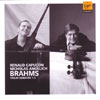Brahms Violin Sonatas
Beautifully considered performances taking an expansive, romantic view
View record and artist detailsRecord and Artist Details
Composer or Director: Johannes Brahms
Genre:
Chamber
Label: Virgin Classics
Magazine Review Date: 11/2005
Media Format: CD or Download
Media Runtime: 79
Mastering:
Stereo
DDD
Catalogue Number: 545731-2

Tracks:
| Composition | Artist Credit |
|---|---|
| Sonata for Violin and Piano No. 1 |
Johannes Brahms, Composer
Johannes Brahms, Composer Nicholas Angelich, Piano Renaud Capuçon, Violin |
| Sonata for Violin and Piano No. 2 |
Johannes Brahms, Composer
Johannes Brahms, Composer Nicholas Angelich, Piano Renaud Capuçon, Violin |
| Sonata for Violin and Piano No. 3 |
Johannes Brahms, Composer
Johannes Brahms, Composer Nicholas Angelich, Piano Renaud Capuçon, Violin |
| Scherzo, 'FAE Sonata' |
Johannes Brahms, Composer
Johannes Brahms, Composer Nicholas Angelich, Piano Renaud Capuçon, Violin |
Author: DuncanDruce
Having greatly enjoyed the Brahms piano trios as played by these artists plus Gautier Capuçon I was keen to hear this disc – and I wasn’t disappointed. Capuçon and Angelich make a wonderfully well-matched team, with a command of genuine rubato (pressing forward in order to make room for subsequent holding back) that gives a truly authentic impression. Each detail of the music is expressively convincing: I sense that it’s a priority for Angelich and Capuçon to feel the music. This can lead them sometimes to go against Brahms’s expressed intentions. The theme at 3’18” in the first movement of Op 78 (track 1) is marked to be in tempo (after a ritardando) but here the speed suddenly becomes faster, the dynamic much louder than the written pianissimo. Similarly, in the Presto agitato finale of Op 108 the quieter passages are taken more slowly – Frank and Serkin show how it’s possible to find the right style for all the mysterious or cantabile sections without letting the onward momentum falter, as Capuçon and Angelich do.
I’d stress, however, that these are occasional lapses. Overall the performances are beautifully considered, tending towards an expansive, romantic view of Brahms, but with a care for balance and proportion. The FAE Scherzo, for example, has all the necessary youthful exuberance, but it’s coupled with a fine feeling for balance between the parts and for rhythmic character. And, throughout, there’s a magnificent sense of line: Capuçon plays the great G-string melodies in Op 108’s Adagio and Op 100’s finale with rich, opulent sound but his vibrato is never too prominent – the most important thing is the shape of the melody.
I’d stress, however, that these are occasional lapses. Overall the performances are beautifully considered, tending towards an expansive, romantic view of Brahms, but with a care for balance and proportion. The FAE Scherzo, for example, has all the necessary youthful exuberance, but it’s coupled with a fine feeling for balance between the parts and for rhythmic character. And, throughout, there’s a magnificent sense of line: Capuçon plays the great G-string melodies in Op 108’s Adagio and Op 100’s finale with rich, opulent sound but his vibrato is never too prominent – the most important thing is the shape of the melody.
Discover the world's largest classical music catalogue with Presto Music.

Gramophone Digital Club
- Digital Edition
- Digital Archive
- Reviews Database
- Full website access
From £8.75 / month
Subscribe
Gramophone Full Club
- Print Edition
- Digital Edition
- Digital Archive
- Reviews Database
- Full website access
From £11.00 / month
Subscribe
If you are a library, university or other organisation that would be interested in an institutional subscription to Gramophone please click here for further information.




